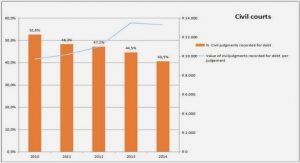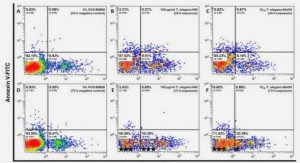Get Complete Project Material File(s) Now! »
Some chemistry background
In this chapter, we present an introduction to the domain of chemistry which will provide the background and the domain-specific terminology which we will use throughout the remainder of this dissertation. Chemistry is the science which studies the structure and interactions of the atoms and molecules from which all of the matter around us is constituted, both living and nonliving. Chemical entities are the atoms, molecules, and substances which are the objects of study by chemists. The study of these entities and their properties and interactions has lead to many of the beneficial developments of the modern world, including life-saving modern medicines, such as antibiotics and anti-cancer drugs (Figure 2.1, a). It has also lead to the development of novel materials such as plastics, synthetic fabrics, strong metal alloys such as stainless steel (Figure 2.1, c), and the complex controlled chemical reactions which underlie the batteries which now power many ubiquitous devices such as cellular phones and cameras, and drive the colourful displays of these devices (Figure 2.1,b). The methods of studying the structure of chemical entities have been applied in the life sciences in the field of molecular biology, where the chemical structure of complex biological molecules such as proteins have been studied together with their mechanisms of interaction both with each other and with smaller molecules (Figure 2.1, d)1.While traditionally an experimental science, advances in theoretical chemistry have allowed increasingly complex predictions to be made about molecules and reactions which have not been observed experimentally. This allows scientists to avoid or defer expensive experimental investigations under certain circumstances. Central to theoretical chemistry are techniques for the modelling and representation of chemical entities, and the complex mathematical theories which are developed based on these models. Computers are used for virtual experiments on theoretical or predicted chemical structures, and they are used to help determine the structures of chemicals contained in samples isolated from nature.As more and more complex calculations have been relegated to the superior computational speed and accuracy of computers, the field of chemoinformatics, which is the application of computers to solve problems in chemistry, has developed many algorithms and techniques which are in common use in chemical and pharmaceutical industries today. But in addition, the domain of chemistry, with its plethora of difficult and even computationally intractable problems, has lead to advances in computing, with the field of chemoinformatics being one of the drivers. It provided early test cases for the development of complex stochastic and heuristic computational techniques which are now widely used in Artificial Intelligence (Trinajstic, 1992).
Chemical entities
All of matter is composed from tiny particles called atoms. Atoms, in turn, are composed from small, solid, positively charged nuclei, surrounded by clouds2 of negatively charged electrons. Electrons are retained by the atom due to the electrostatic attraction between the negatively charged electrons and the positively charged nucleus. An atom which is neutral overall has the same number of electrons as protons, since electrons and protons have equal but opposite charges. Atoms have different types depending on the number of protons in the nucleus, which is called the atomic number. A hydrogen atom, for example, has one proton in its nucleus,thus has atomic number one. Carbon, on the other hand, has six protons in the nucleus, thus has atomic number six. Atoms which have the same atomic number are defined as being of the same chemical element, and share many important properties. There are 112 known elements. Different numbers of neutrons in the nucleus of atoms of the same element lead to atoms of the same types but with different weights, called isotopes (Figure 2.2 illustrates the isotopes of Hydrogen). However, the reactivity is much the same for different isotopes, as the reactivity is largely driven by electrostatic factors which depend on the protons and electrons, and only somewhat affected by the total mass,which depends on the number of protons and neutrons together, of the nucleus. Electrons are arranged around the nucleus of the atom in regions called orbitals, each of which can house a maximum of two electrons. The outermost orbitals form the location of the reactivity of the atom.Definition 2.1. An atom is a small, massive, positively charged nucleus surrounded by a cloud of negatively charged electrons. In an atom of neutral charge, there are as many protons in the nucleus of the atom as there are electrons in the electron cloud. Definition 2.2. An isotope is the name for the different variants of atoms which have the same atomic number, i.e. the number of protons in the nucleus, but different numbers of neutrons. For example, Carbon has atomic number 6 but isotopes with mass number, i.e. number of protons and neutrons together, 12, 13, and 14.Definition 2.3. An ion is an atom with a non-zero charge, either positive or negative.
Charge occurs in integral units (…,-2,-1,0,1,2,…) which count the number of extra, or missing, electrons surrounding that atom relative to the number of protons in the nucleus.Atoms themselves are very small and the number of different kinds of atoms is not large enough to account for the range and diversity of chemical substances we observe.
CHEMICAL ENTITIES
around us. However, atoms commonly join together semi-permanently in a process called chemical bonding to form molecules, which consist of multiple atoms joined together in stable configurations. There are many different ways for atoms to join together through a wide range of bond strengths and flexibilities. The strongest bond is the covalent bond, which is when two atoms share a pair of electrons in an energetically stable orbit between them. Units of covalently bound atoms are called molecules. Ionic bonding occurs when electrostatic attraction brings together a positively charged atom or molecule and a negatively charged atom or molecule.
List of Figures
List of Tables
List of Acronyms
1 Introduction
1.1 Research questions
1.2 Out of Scope
1.3 Statement of the contributions
1.4 Structure
2 Some chemistry background
2.1 Chemical entities
2.2 Properties of chemical entities
2.3 Chemical substances
3 Chemical Structures
3.1 Representation
3.1.1 MOLfile
3.1.2 Chemical Markup Language
3.1.3 SMILES
3.1.4 InChI and InChIKey
3.2 Sources of chemical data
4 Description Logics
4.1 Logical representation
4.2 Semantic networks and frames
4.3 From semantic networks to Description Logics
4.3.1 A note about syntax
4.4 The definition of complex concepts
4.4.1 Constructors
4.4.2 The TBox
4.5 Knowledge about individuals
4.5.1 Defining a Description Logics (DL) knowledge base
4.6 Semantics
4.7 Reasoning
4.7.1 Terminological inferences
4.7.2 Assertional inferences and query answering
4.7.3 Open world semantics
4.7.4 Decidability and complexity
4.8 Basic DL languages
5 Rules
5.1 Semantics
5.2 Reasoning
6 OWL – the Web Ontology Language
6.1 Background
6.1.1 A note about terminology
6.2 Expressivity and Web Ontology Language (OWL) flavours
6.3 Notes on semantics
6.4 OWL Syntaxes
6.5 Tools for working with OWL ontologies
6.6 Semantic Web Rule Language
7 Representing chemical structures in OWL
7.1 Structured Objects
7.2 Representation in TBox
7.3 Representation in ABox
7.4 Representation with Rules
8 Description Graphs
8.1 Definition
8.2 Decidability of Reasoning
8.2.1 Boundedness of graphs
8.2.2 Separation of properties
8.2.3 Acyclicity
8.3 Rules
8.3.1 Definition
8.4 Implementation
9 Software design and implementation
9.1 Overview
9.2 Architecture
9.2.1 Downloadable files
9.3 Software libraries
9.3.1 Chemical data conversion
9.3.2 Programmatic manipulation of OWL ontologies
9.3.3 Reasoning over graph-enriched knowledge bases
9.4 Implementation
9.4.1 Ontology
9.4.2 Description Graphs
9.4.3 Rules
10 Results
10.1 Classification based on substructures
10.2 Determination of chemical properties from graphs
10.3 Scalability of reasoning over knowledge base
11 Discussion
11.1 Structure-based chemical classification by expert systems
11.2 Related work
11.3 Comparison of our research to previous efforts
12 Conclusion
Bibliography
Appendices






